Managing an Instagram presence today isn’t just about posting a pretty picture. It’s about timing, engagement, insights, consistency, and content flow delivered with intention. Whether you’re a solo entrepreneur building a personal brand or a small team launching a product line, the right social media tool can be the difference between posting and growing.
This is your in-depth, no-fluff breakdown of the best tools available today for Instagram management, designed specifically with small businesses and influencers in mind.
Over the past few years, with our SMM team, we’ve tested nearly all of these tools – some in agency settings, others while supporting small ecomm brands and solopreneurs. I’ll share where each one shines (and where I personally got stuck).
Let’s dive into what works, what doesn’t, and which tool fits your unique goals.
1. Later – The Visual-First Planner for Instagram-Driven Brands
Later is built with Instagram in mind, especially if your brand thrives on visual storytelling. Its intuitive drag-and-drop calendar and Linkin.bio feature make it ideal for users who want their grid to look curated while also being shoppable and strategic.
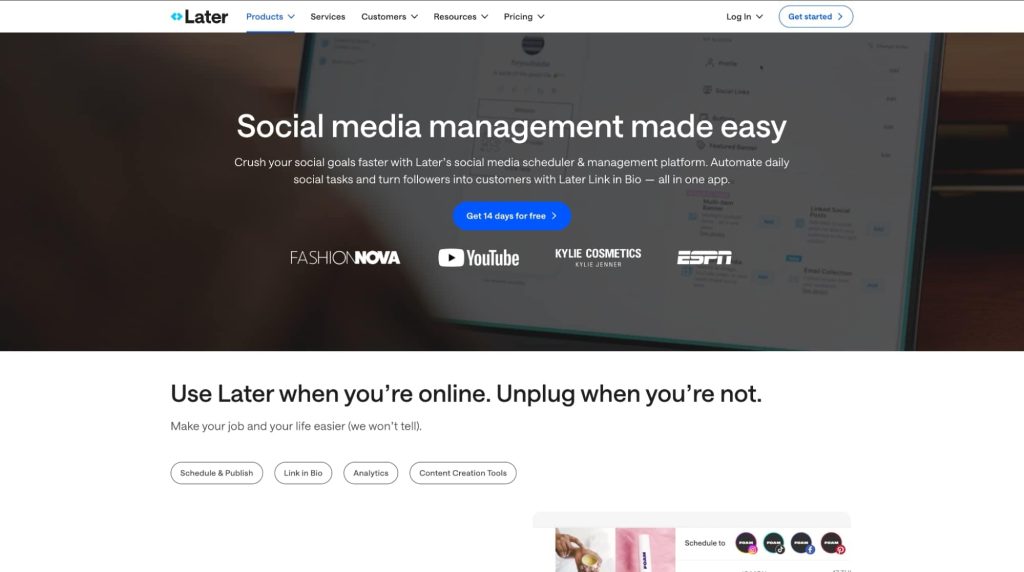
✅ Pros:
- Visual content calendar: Lets you see how your feed will look, which is vital for brands where aesthetics drive engagement (fashion, wellness, interior design).
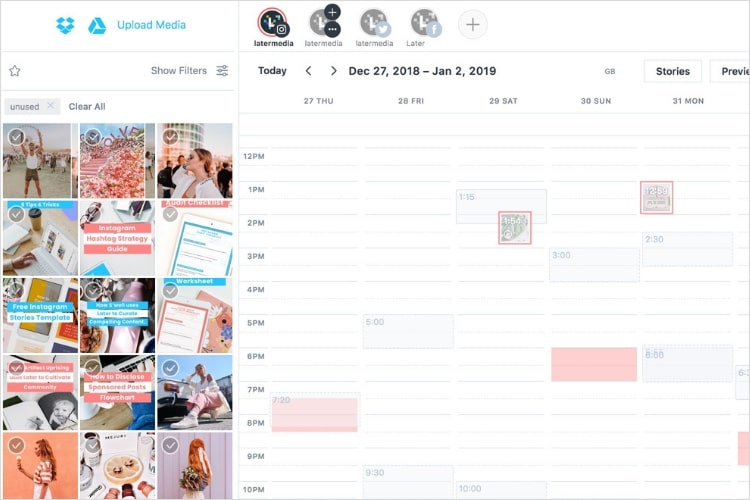
- Drag-and-drop grid planner: Saves time and makes it easy to batch-plan posts with visual consistency – a top priority for influencers and brands with visual identity.
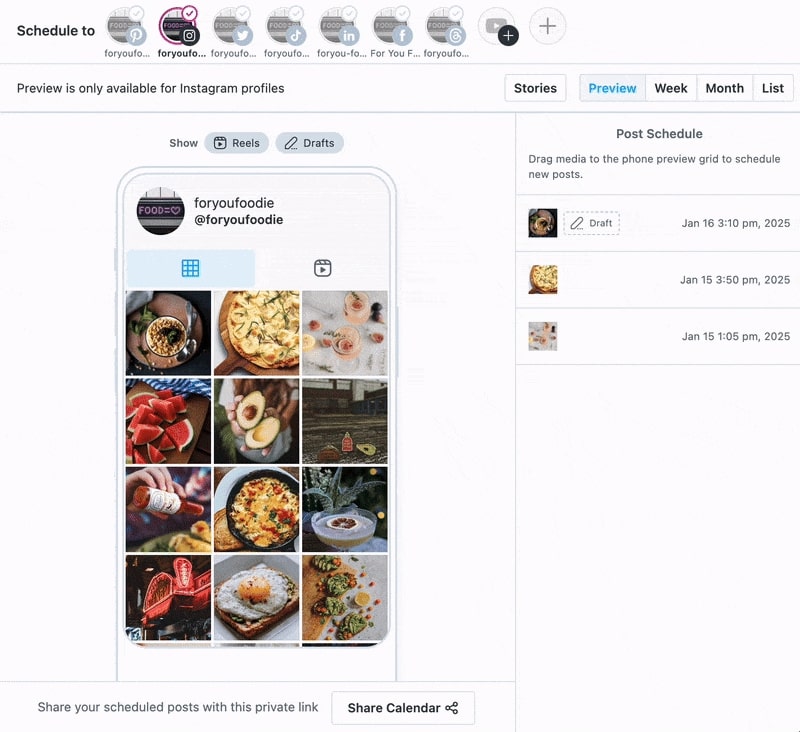
- Linkin.bio feature: Circumvents Instagram’s single-link limitation, allowing you to direct traffic from posts to specific product pages or articles (key for ecommerce conversion.
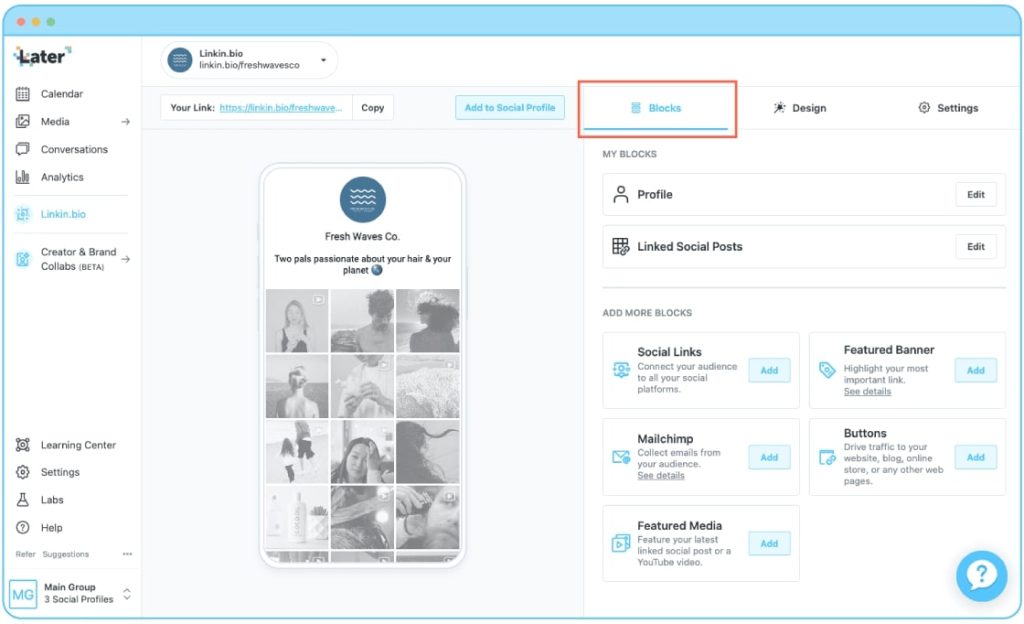
- Post, story, and Reel planning: Supports multiple formats so you can diversify your content strategy in one platform, increasing reach and engagement.
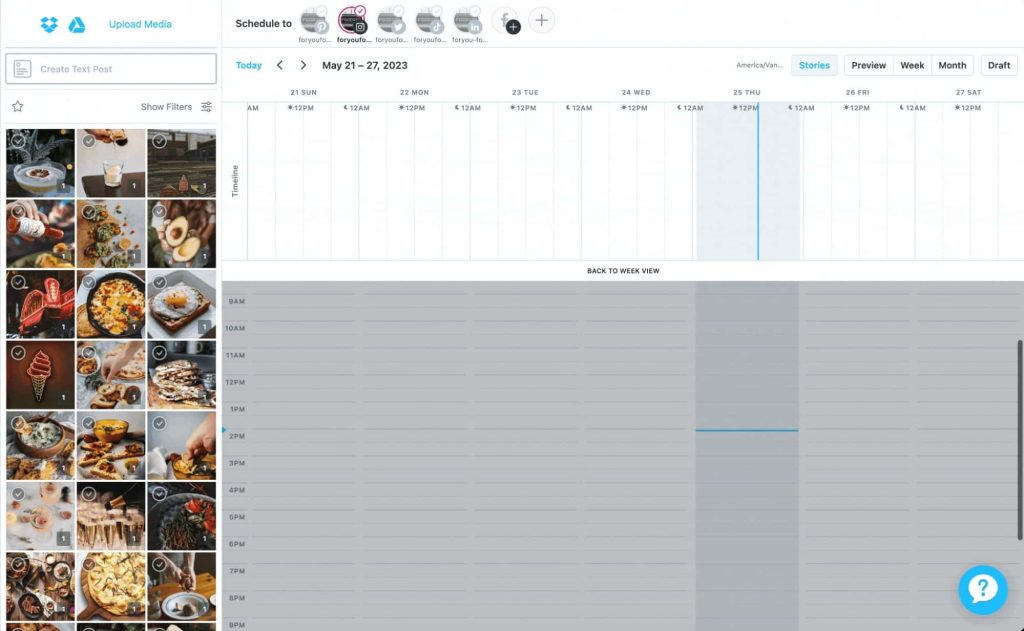
❌ Cons:
- Basic analytics unless you’re on a paid tier
- No in-depth engagement or comment management features
💰 Pricing:
- Starter: $16.67/month (billed annually) – 1 user, 1 social set, 30 posts per profile
- Growth: $30/month (billed annually) – 3 users, 3 social sets, 150 posts per profile
- Advanced: $53.33/month (billed annually) – 6 users, 6 social sets, unlimited posts per profile
👔 Best For:
- E-commerce brands with a strong aesthetic (fashion, beauty, home décor)
- Influencers focused on feed design and brand partnerships
- Small business owners who prioritize visuals over data
I used Later while managing a fashion brand’s Instagram, and the visual planner was a game-changer. It saved hours every week when prepping seasonal content drops.
So, if you’re a fashion boutique owner curating your seasonal collections in advance, Later’s drag-and-drop planner lets you map out your feed for an entire month in a single sitting, so you can focus on selling, not scrambling.
2. Buffer – Lightweight, Efficient, and Great for Beginners
Buffer is a classic in the social media world. Its minimalist interface and fast scheduling make it excellent for users who want a clean experience without extra noise.
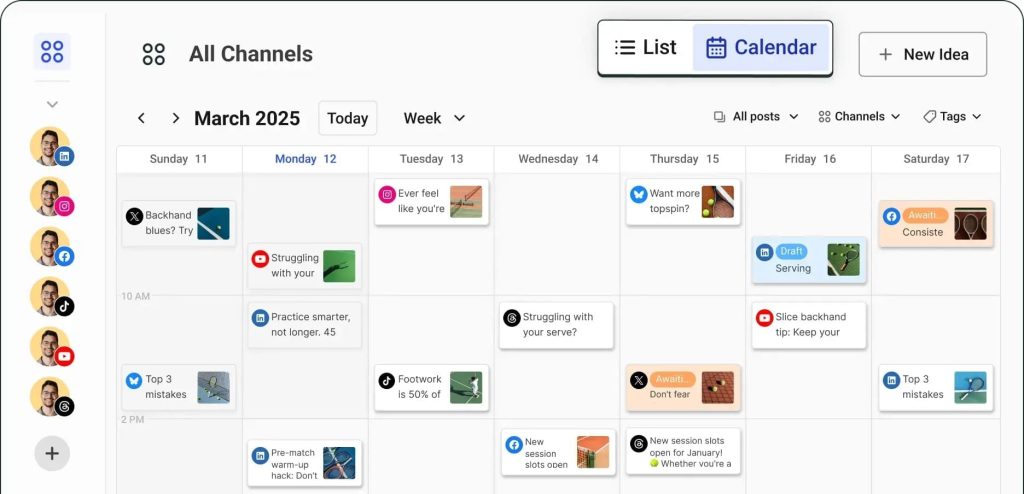
✅ Pros:
- User-friendly: Great for those who aren’t “techy”. Solopreneurs or consultants can get up and running quickly, without spending hours learning new software.
- Multi-platform posting: Ideal if you’re cross-promoting content (Instagram, Facebook, X/Twitter), helping small teams stretch their reach with minimal effort.
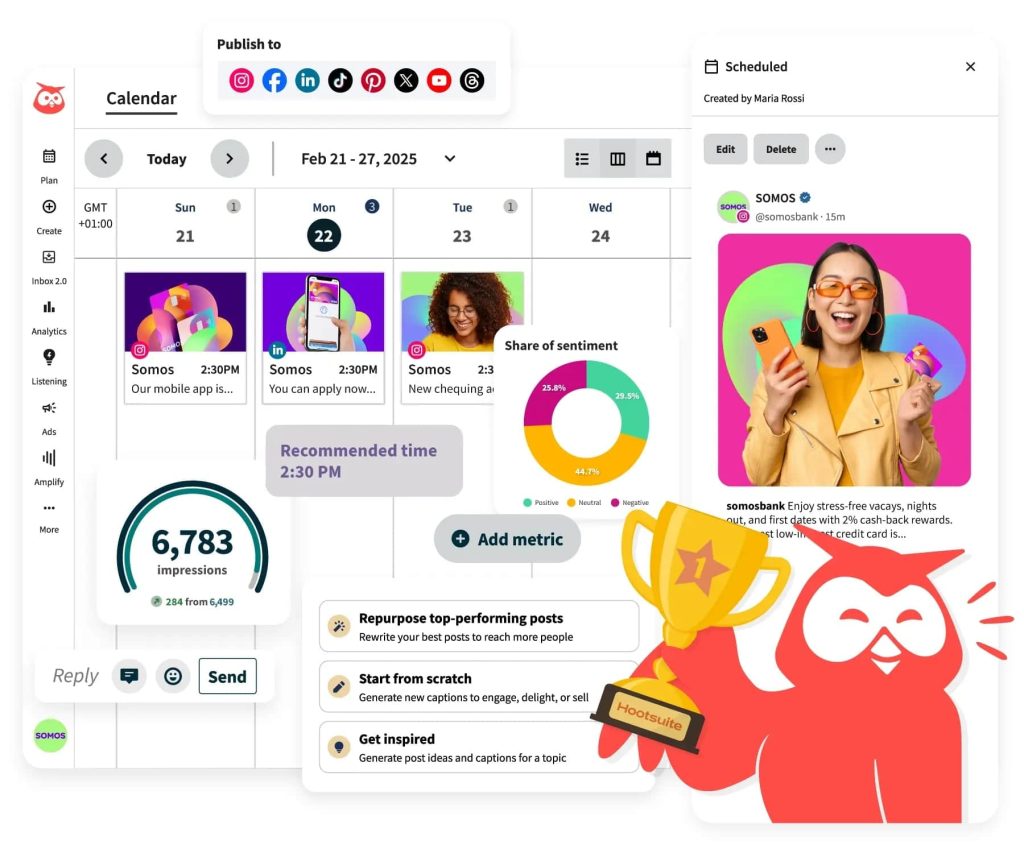
- Mobile-friendly: Enables quick edits and on-the-fly changes, crucial for creators who manage social media while juggling a busy schedule.
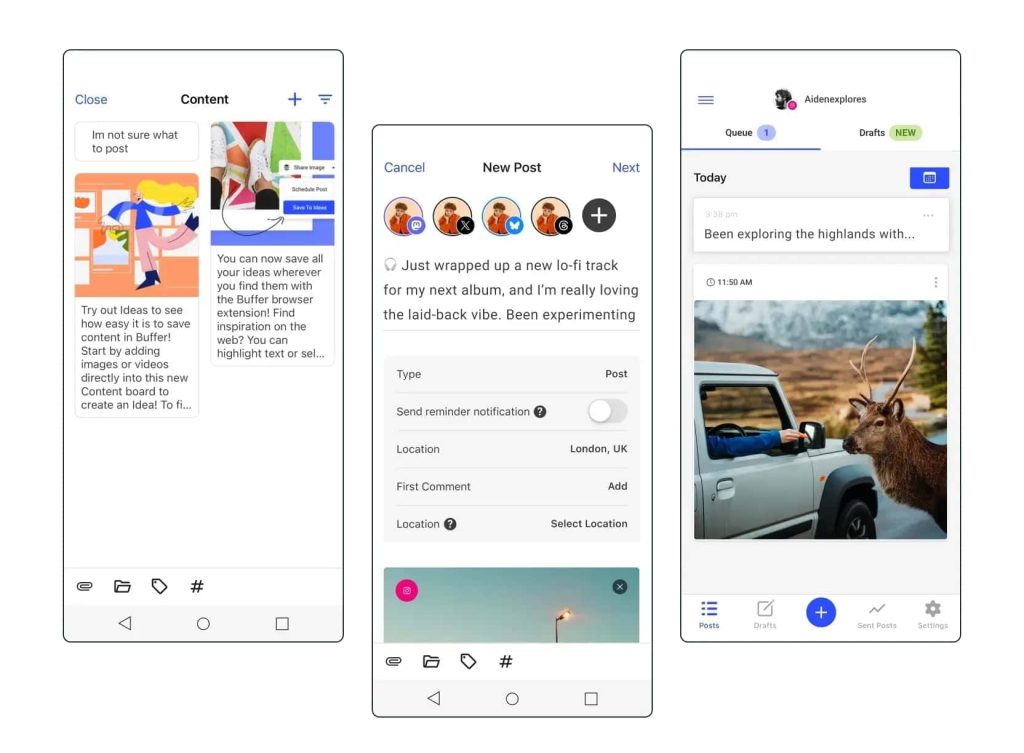
- Basic analytics included: Gives a snapshot of performance, helping you make smarter posting decisions even on the lower-tier plans.
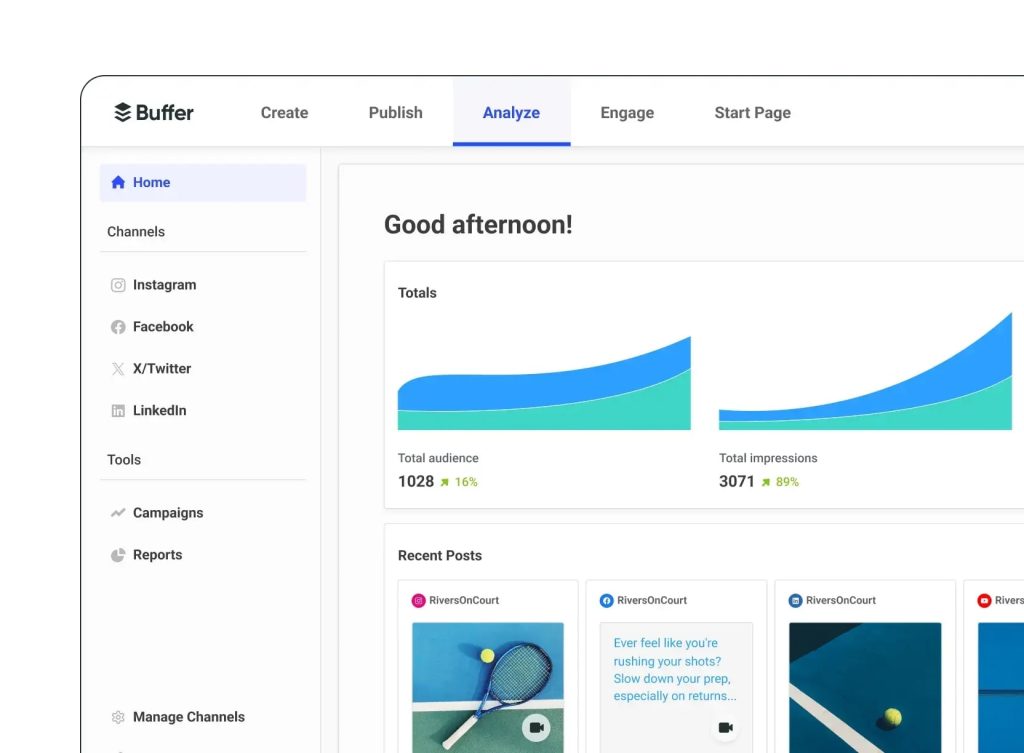
❌ Cons:
- No Instagram feed preview: This means you can’t visualize how your grid will look; problematic for brands focused on aesthetic cohesion.
- Limited feature depth: Doesn’t offer hashtag research, competitor analysis, or engagement tools, so you may outgrow it as your strategy evolves.
💰 Pricing:
- Free plan available
- Essentials: $6/month per channel
- Team: $12/month per channel
- Agency: $120/month for 10 channels
👔 Best For:
- Coaches, freelancers, and consultants needing simple scheduling
- Influencers starting out or managing multiple platforms lightly
I recommend Buffer to clients who are just starting out—especially solo coaches or consultants—because it’s clean and hard to mess up. Whereas, I do wish it had grid previews though. For one personal project, I had to use another app just to double-check how the feed looked.
3. Sprout Social – Enterprise-Level Power for Serious Strategy
Sprout Social blends publishing, analytics, and engagement. It’s one of the most comprehensive tools on the market and is ideal for businesses ready to level up their Instagram presence.
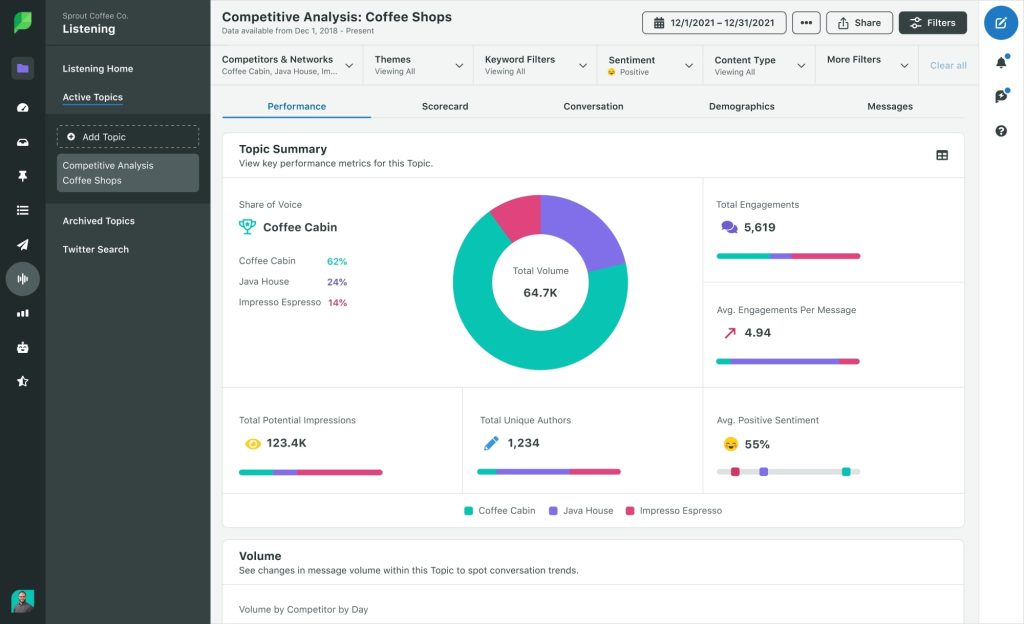
✅ Pros:
- Robust analytics: Offers detailed reports on engagement, demographics, best times to post, perfect for optimizing strategy and proving ROI.
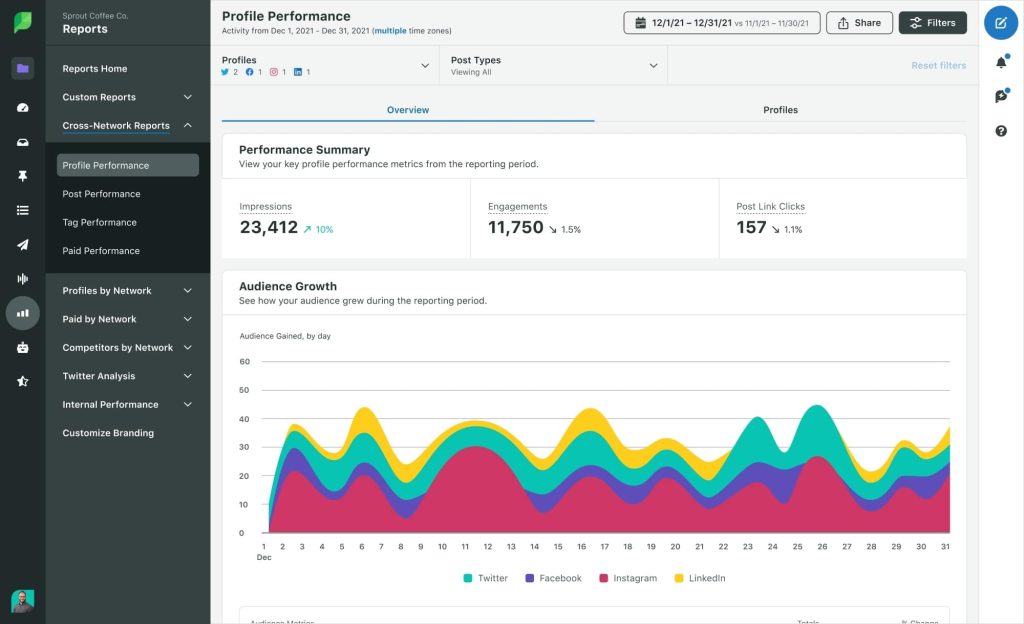
- Unified inbox: Centralizes comments, DMs, and mentions, saving you time while improving response rates. A game-changer for brands with active audiences.
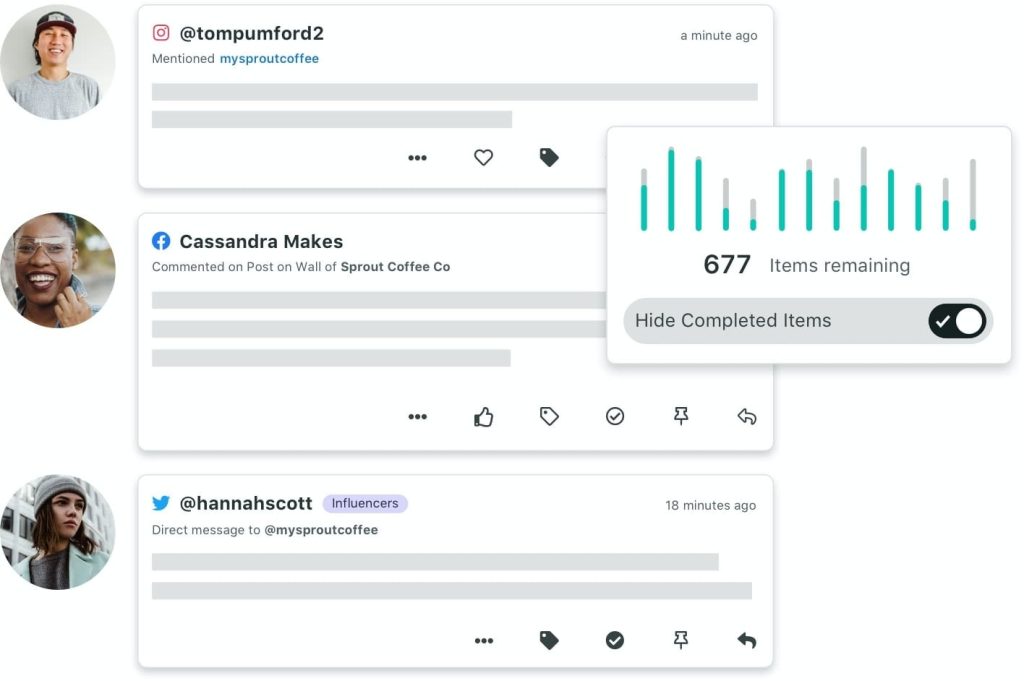
- Collaboration features: Teams can assign tasks, approve content, and leave feedback—great for marketing departments or influencer managers.
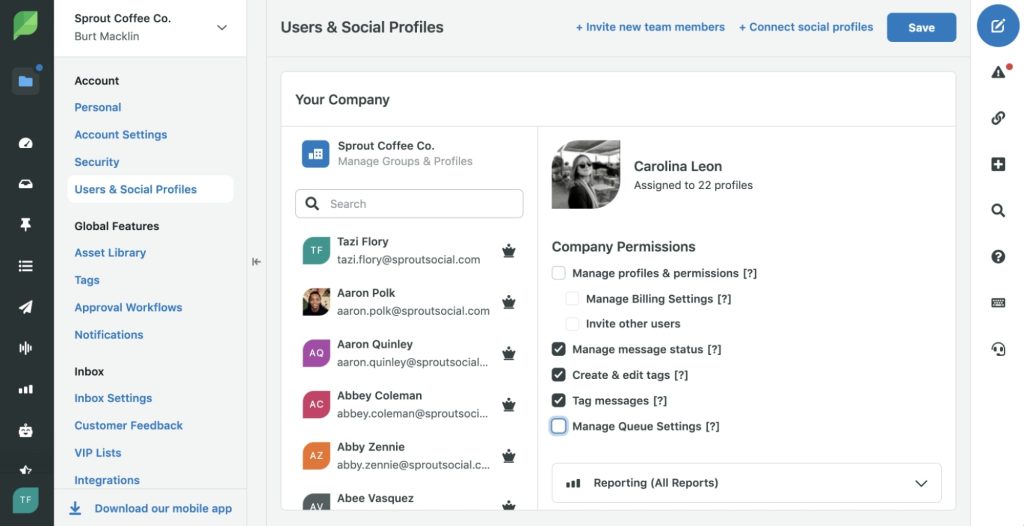
- Audience CRM tools: Tracks past interactions and user history, helping you nurture repeat customers and loyal followers.
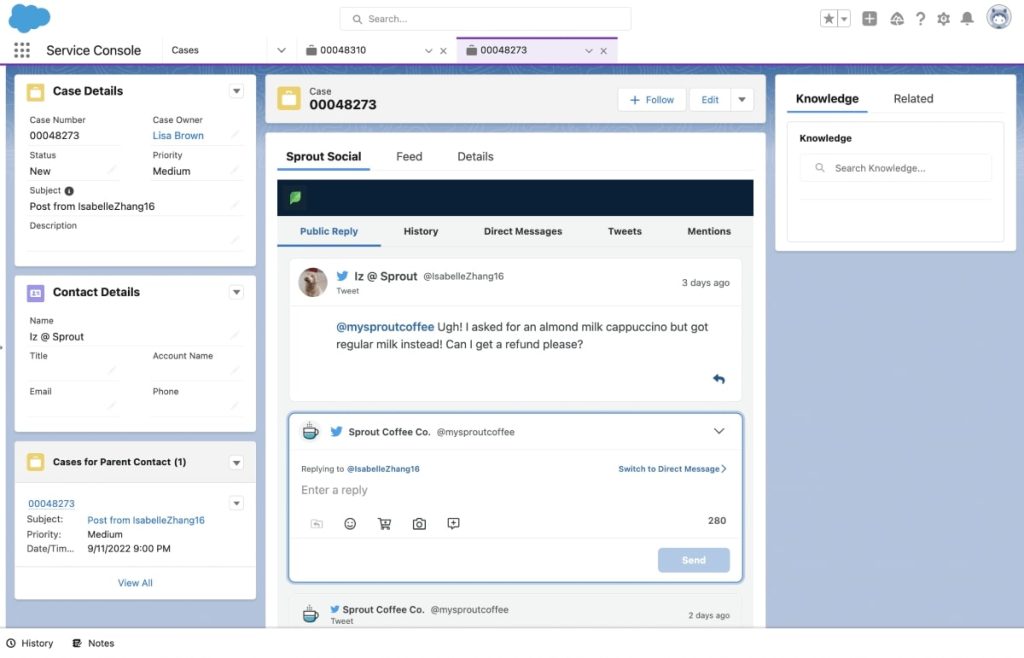
❌ Cons:
- High cost: The $199+ monthly price tag is hard to justify for solo creators or very small businesses, especially when basic features might suffice.
- Overwhelming for basic needs: If you just want to schedule and track a few posts a week, the advanced tools may be unnecessary and overly complex.
💰 Pricing:
- Standard: $199/month
- Professional: $299/month
- Advanced: $399/month
👔 Best For:
- Growing ecommerce brands and customer service teams
- Influencers with high-volume engagement or brand deals
I’ve demoed Sprout with a larger client, and while the analytics are impressive, the interface felt overwhelming at first. Definitely not plug-and-play for smaller teams 💸
4. Planoly – Design-Centric Scheduling for Grid-Obsessed Brands
Planoly is a favorite for visually minded businesses. Its strength lies in its focus: clean feed planning, batch content creation, and post design all in one.
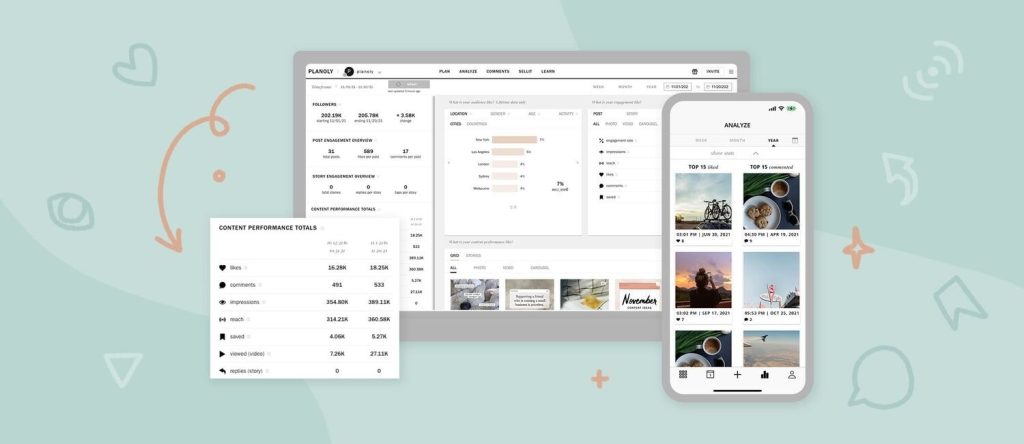
✅ Pros:
- Grid preview: Helps you curate a visually harmonious feed, which is crucial when first impressions affect trust and follow rates.
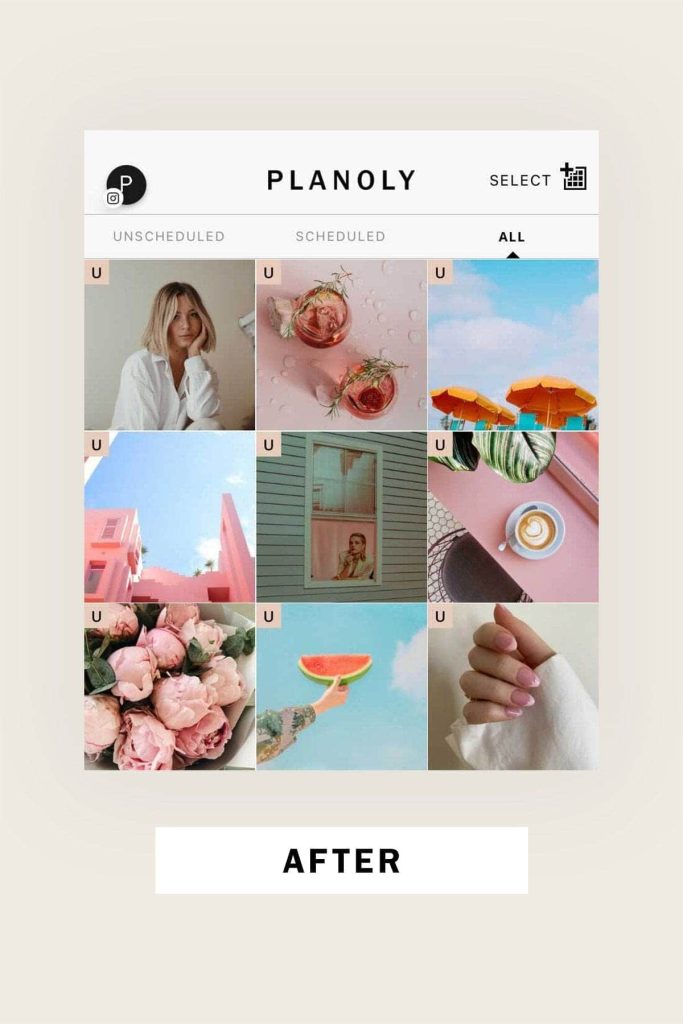
- Canva integration: Allows seamless design within the app, also ideal for businesses without an in-house designer or external tools.
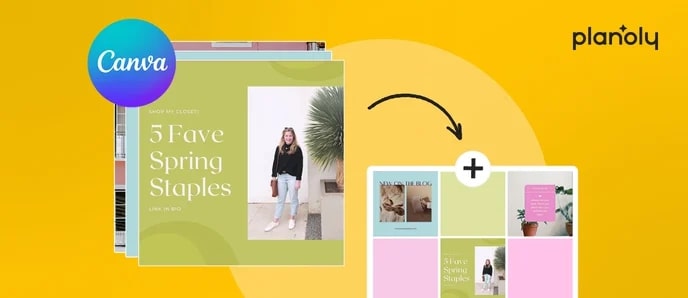
- Hashtag storage: Speeds up scheduling by letting you save and reuse effective hashtag sets, which improves discoverability.
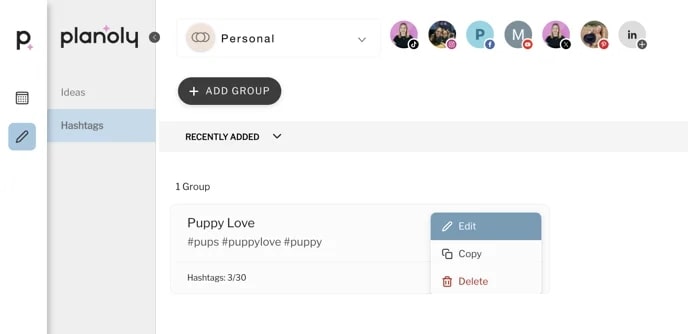
- Supports story planning: Lets you time out visual storytelling in advance, giving creators more control over narrative flow.
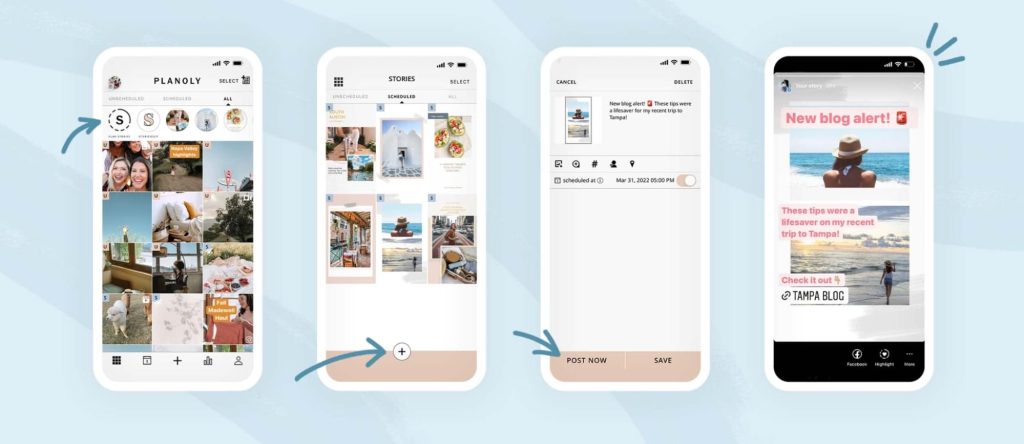
❌ Cons:
- Limited analytics: Hard to evaluate what works long-term without upgrading. Makes growth data inaccessible for budget-conscious users.
- No engagement management: You’ll still need to reply to comments or messages manually through Instagram, which slows response time.
💰 Pricing:
- Starter: $16/month
- Growth: $28/month
- Pro: $43/month
👔 Best For:
- Fashion, beauty, and visual brands
- Influencers doing sponsored content with brands who care about layout
I haven’t used Planoly extensively myself, but I know several beauty brand founders who swear by it for creating that “scroll-stopping” first impression. So, why not giving a try.
5. Iconosquare – Analytics-Heavy for Brands Focused on Growth
Iconosquare is analytics-first, and it shows. It gives deep insights into post performance, audience behavior, and content trends. Ideal if data drives your decisions.
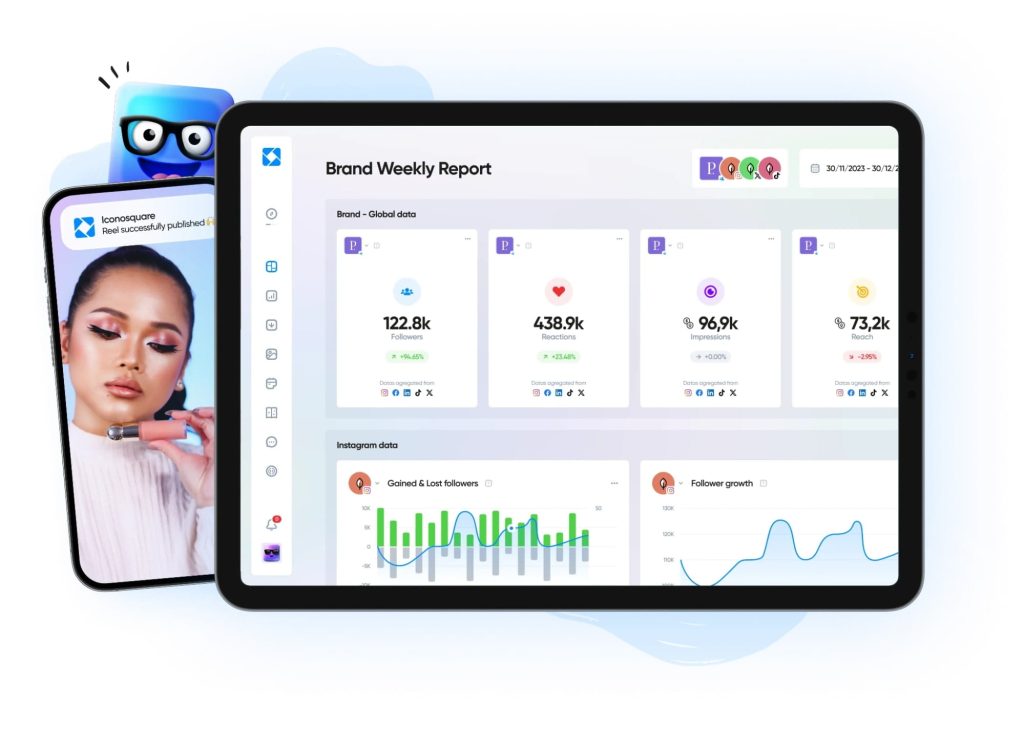
✅ Pros:
- In-depth analytics: Shows follower growth, engagement rates, post reach. Key for adjusting strategy and measuring campaign success.
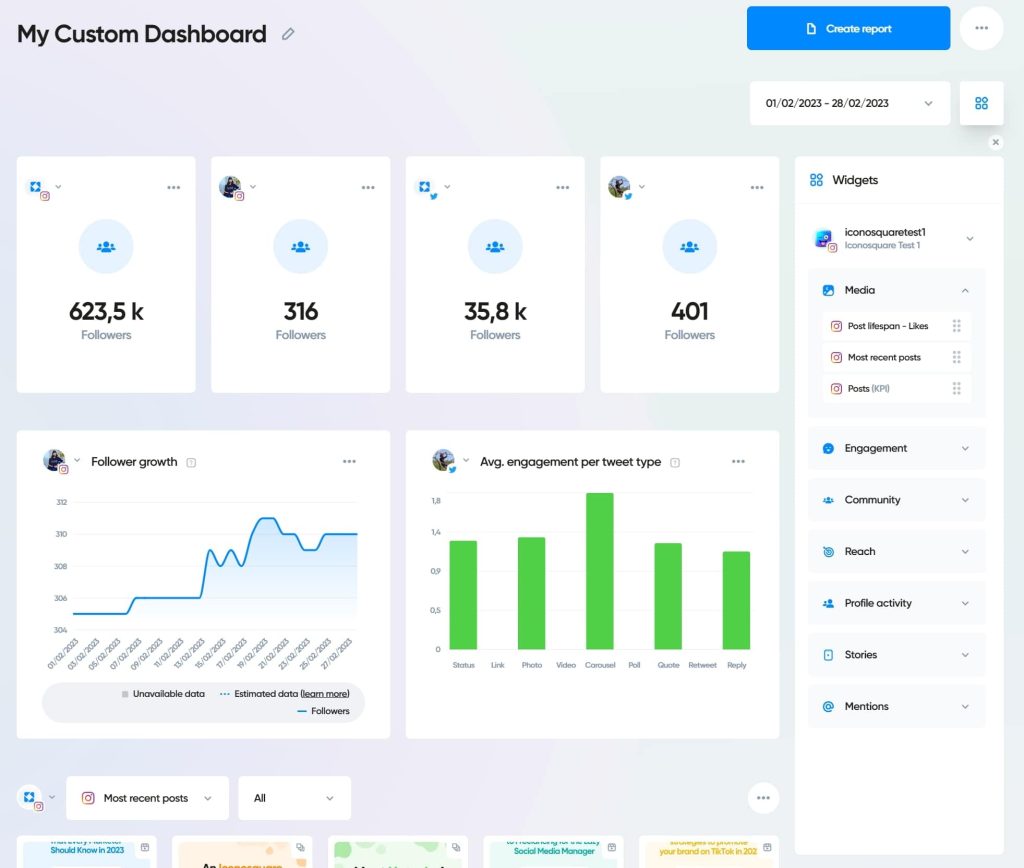
- Competitor tracking: Lets you benchmark against similar accounts. A strategic tool for staying competitive and spotting opportunities.
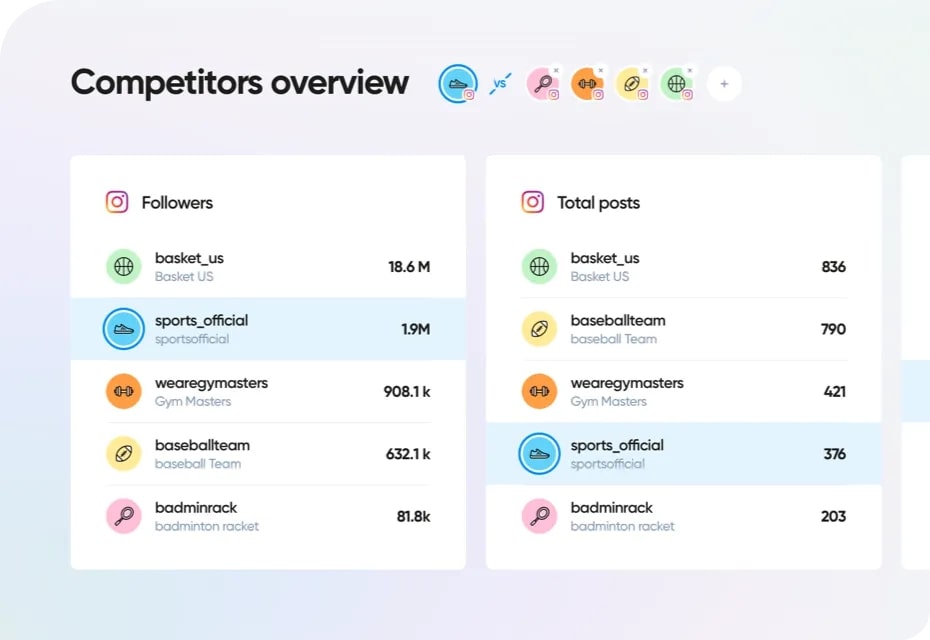
- Story metrics: Many tools ignore Stories, but Iconosquare includes them. Useful for understanding real-time engagement.
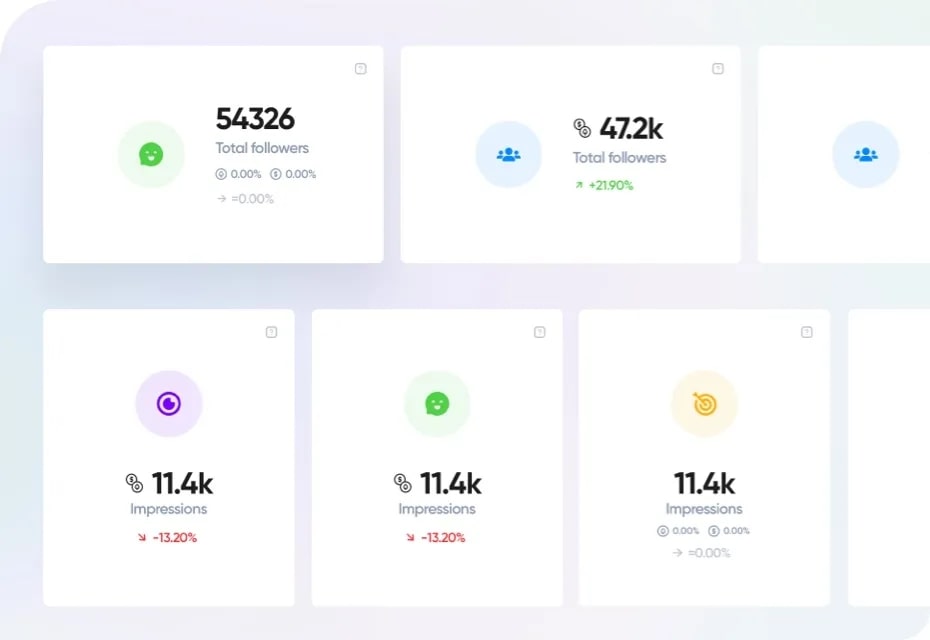
- Exportable reports: Professional reports are great for influencer media kits or agency-client reporting.
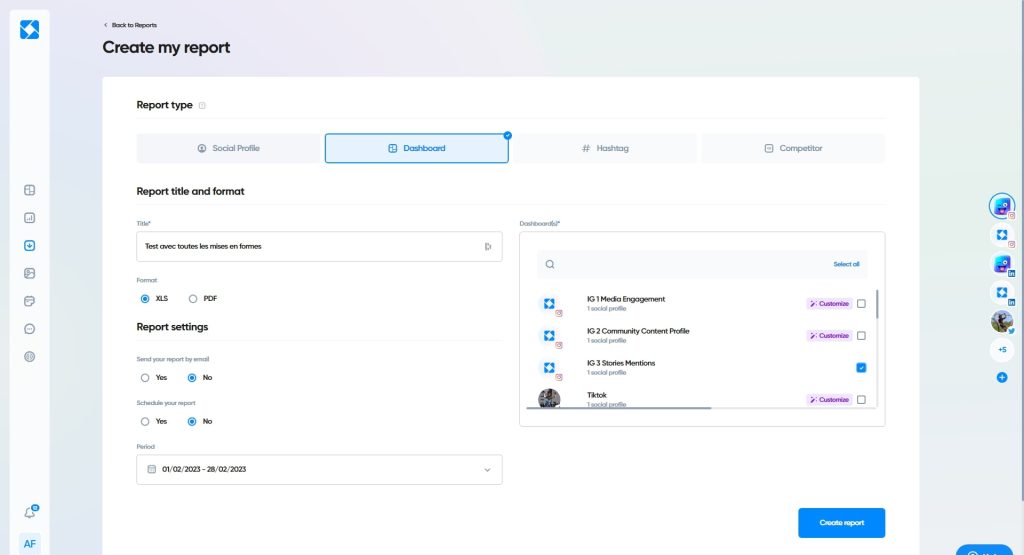
❌ Cons:
- Scheduling limited on lower tiers: Analytics may be strong, but content publishing is restricted unless you upgrade (creating friction for daily managers).
- No community engagement features: You can’t reply to DMs or comments from inside the platform, so it doesn’t replace your need to check Instagram daily.
💰 Pricing:
- Pro: $49/month
- Advanced: $79/month
- Enterprise: Custom pricing
👔 Best For:
- Influencers pitching to sponsors
- Agencies and data-driven marketers
I used Iconosquare while managing a paid influencer campaign for an e-commerce client, and it was a beast when it came to actionable insights such as follower growth trends, story performance, and engagement breakdowns were all top-notch. It really helped us fine-tune our posting strategy and justify ROI to the client.
That said, I quickly realized its scheduling features felt limited unless you upgraded. We ended up pairing it with a separate tool for content publishing just to keep things running smoothly day to day.
If data is your priority, it’s a winner, but for full workflow management, it might need a sidekick.
6. SocialBee – Automation Meets Flexibility
SocialBee is all about systematizing your Instagram workflow. Its category-based scheduler helps you maintain consistency and reduce manual planning.
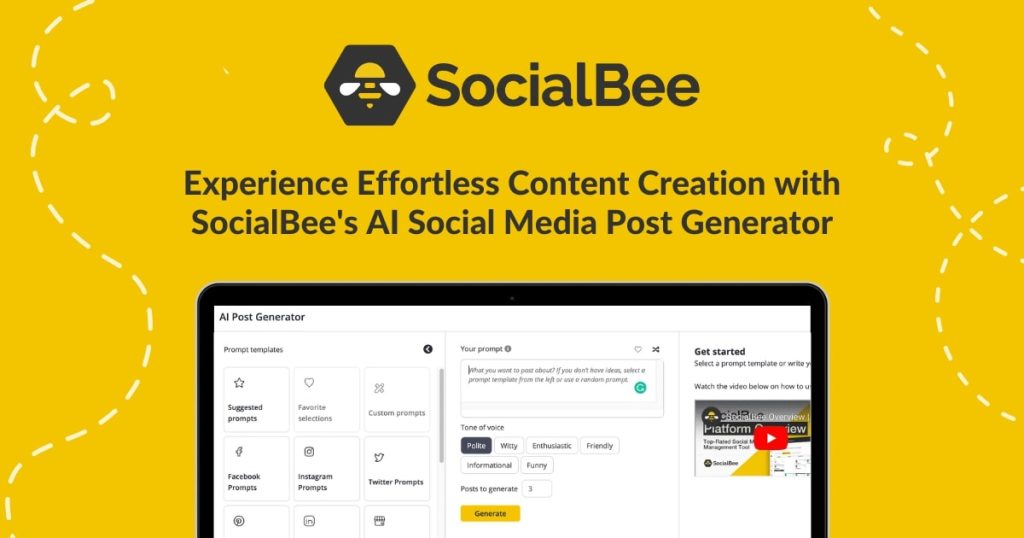
✅ Pros:
- Content categories: Helps organize posts (quotes, tips, products) for balanced, automated scheduling. Perfect for time-strapped users.
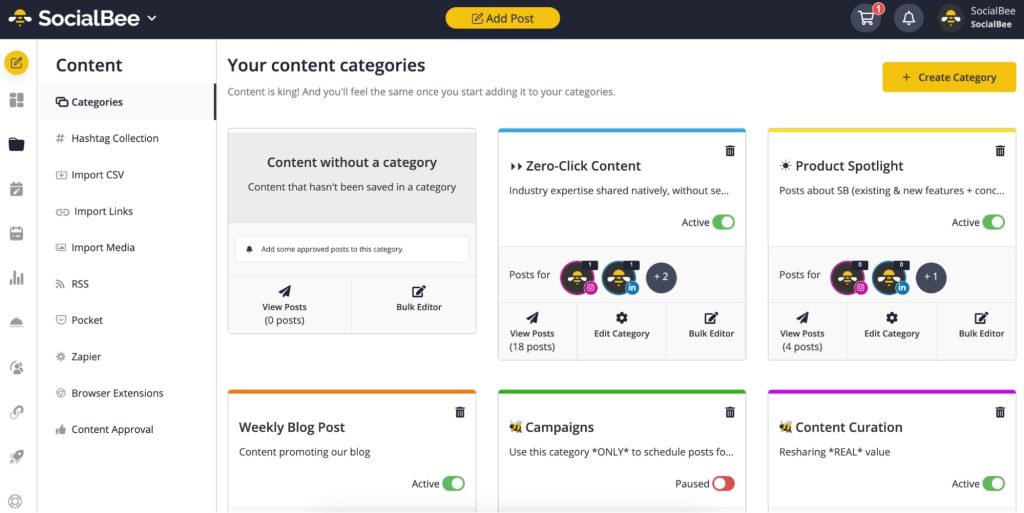
- AI post generation: Speeds up creation, useful for brands that struggle with consistent ideation.
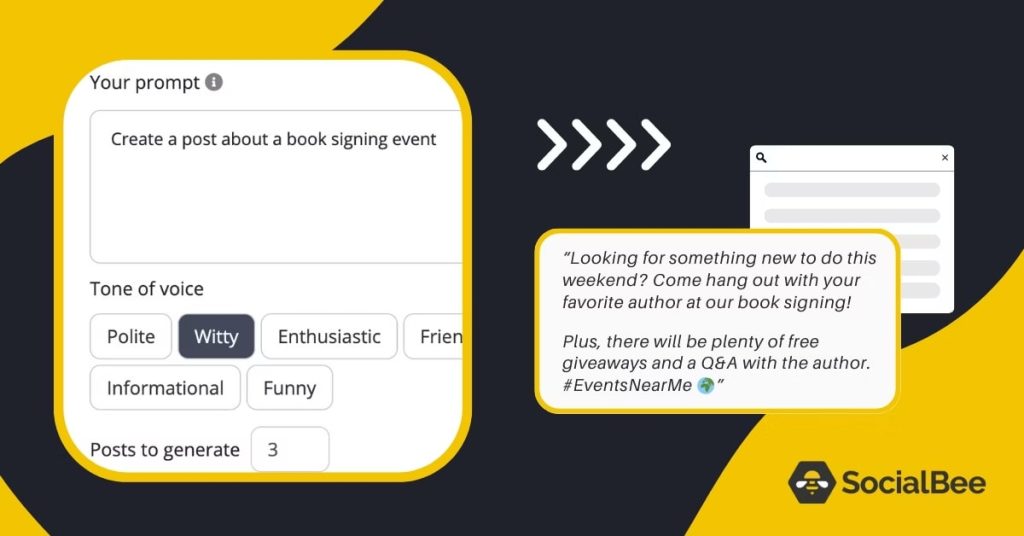
- Evergreen content recycling: Extends the life of high-performing posts, maximizing reach without always creating new content.
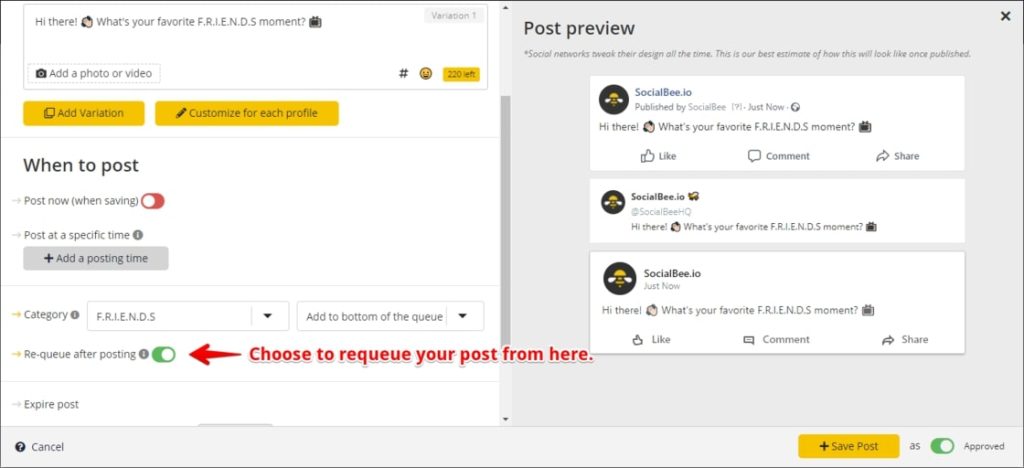
- Broad platform support: If you plan to expand beyond Instagram (LinkedIn, Twitter, Facebook), you’re already set up.
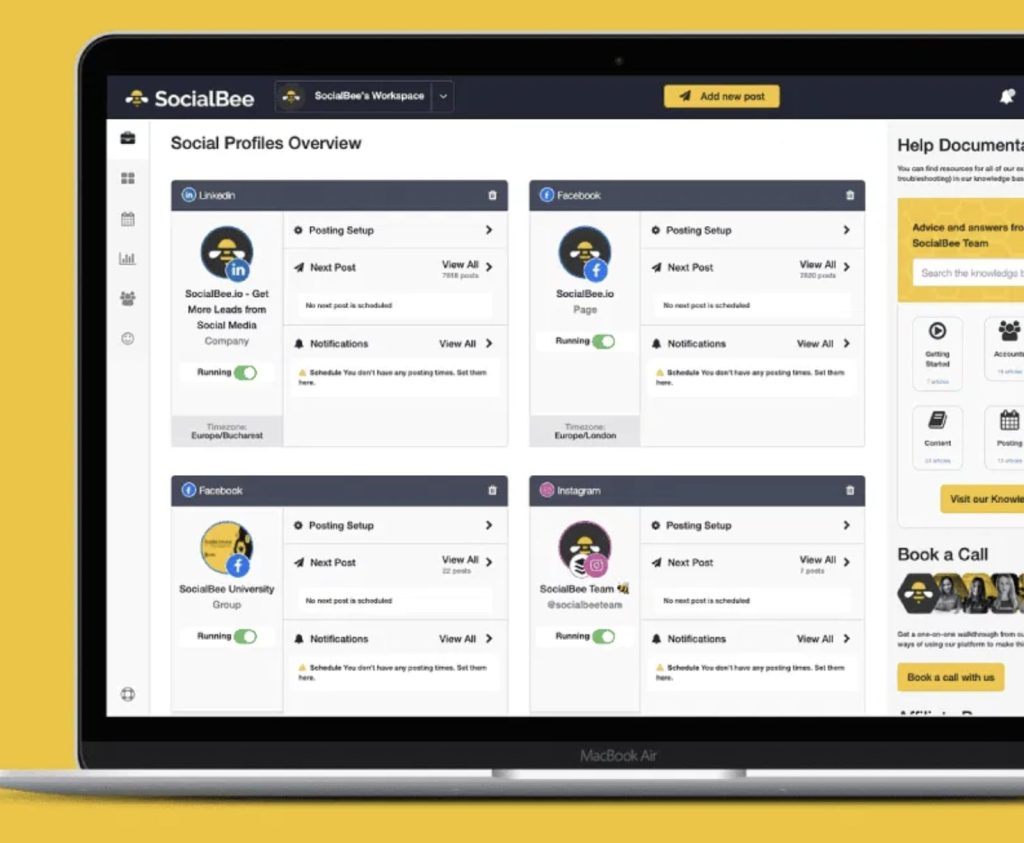
❌ Cons:
- Interface isn’t as polished: Visually it can feel clunky, which may turn off creative professionals or designers.
- Steeper learning curve: Features like content queues and rules take time to configure, which might discourage users who just want a quick scheduler.
💰 Pricing:
- Bootstrap: $29/month
- Accelerate: $49/month
- Pro: $99/month
👔 Best For:
- Coaches, educators, and evergreen content creators
- Influencers building thought leadership or repurposing long-form content
SocialBee was definitely a learning curve at first. The interface isn’t the most intuitive, and setting up content categories took a bit of upfront planning. But once I got it dialed in for a SaaS brand I was supporting, it ran like a machine. We were able to automate our weekly cadence of thought-leadership posts, product tips, and testimonials without having to touch the calendar every few days.
7. Loomly & CoSchedule – Campaign Builders for Structured Teams
If your brand runs structured marketing campaigns (product launches, seasonal sales), Loomly or CoSchedule helps align your team, calendar, and execution. Both serve the same niche use case: structured content planning for teams and campaign-based workflows.
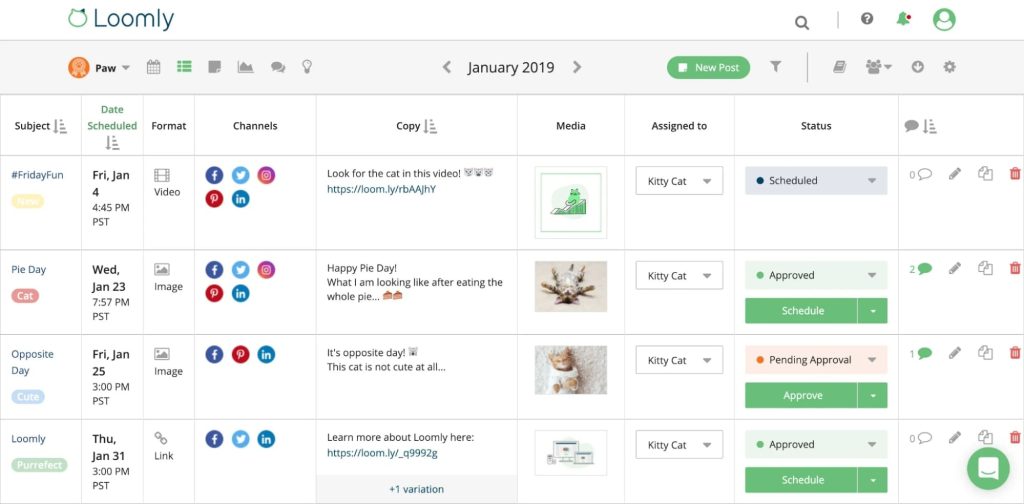
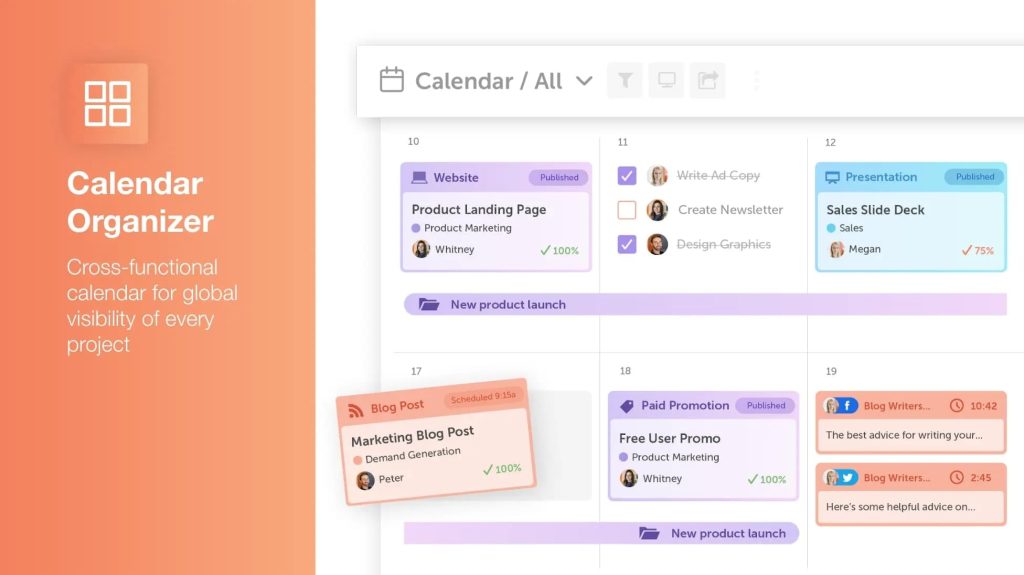
✅ Pros:
- Team workflows: Assign tasks, approve drafts, and manage roles. Ideal for growing businesses or influencer teams with designers, writers, and strategists.
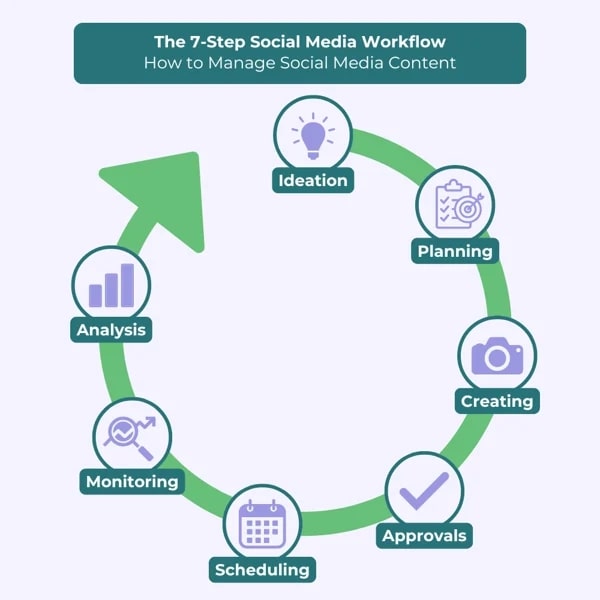
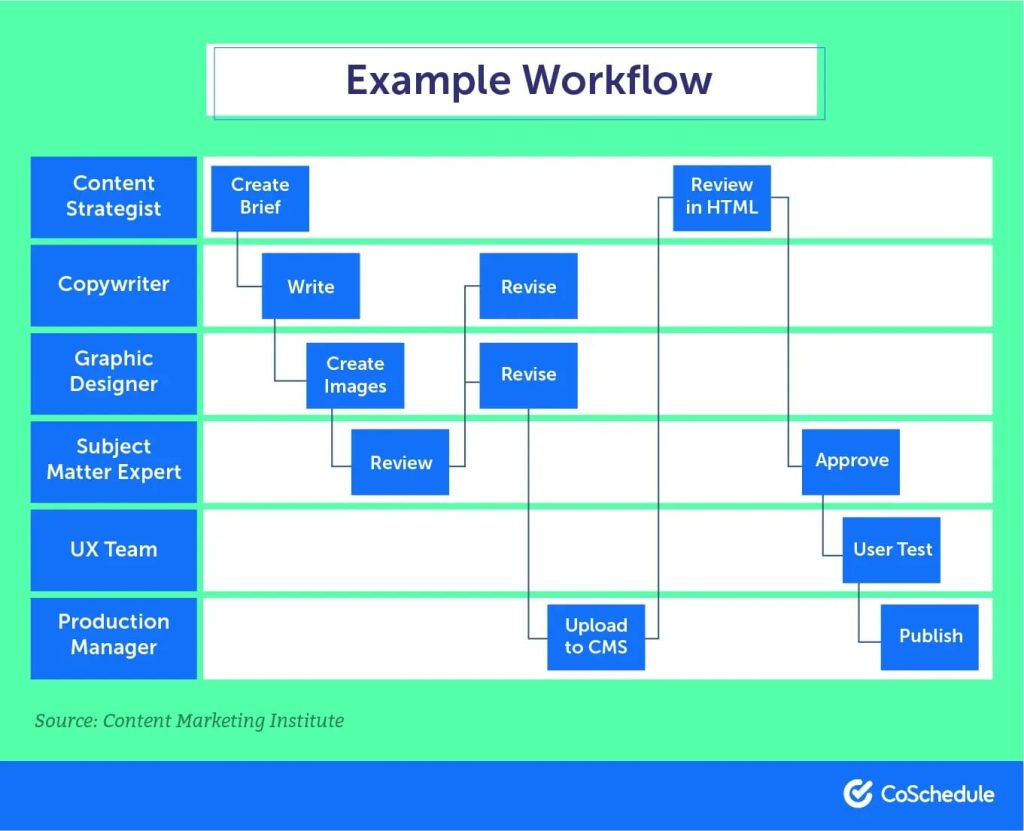
- Live post previews: See how content appears before publishing, reducing error risk.

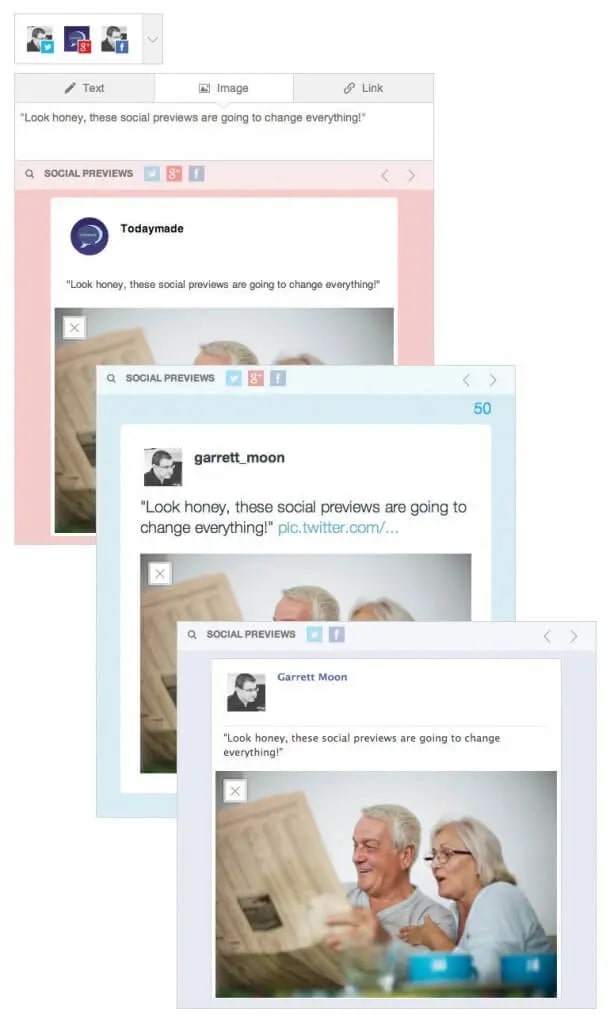
- Asset library: Stores past creatives and templates, improving brand consistency and reducing content production time.
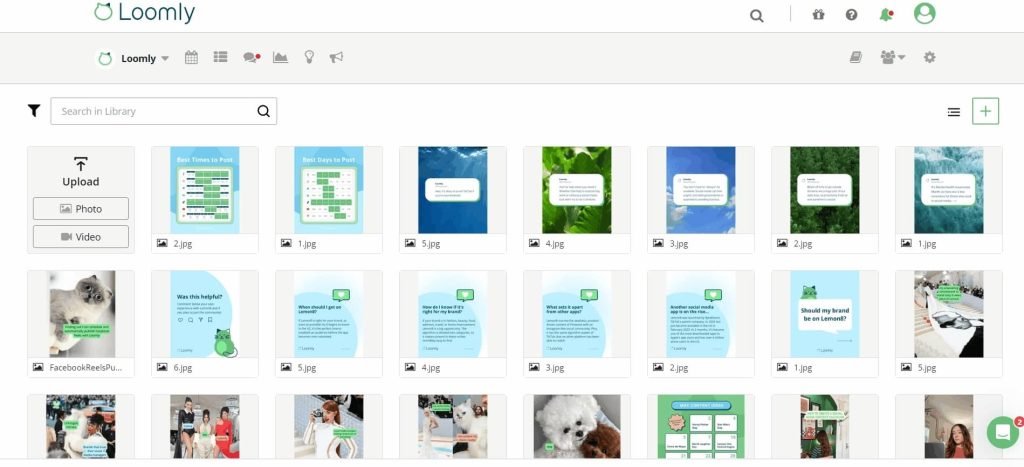
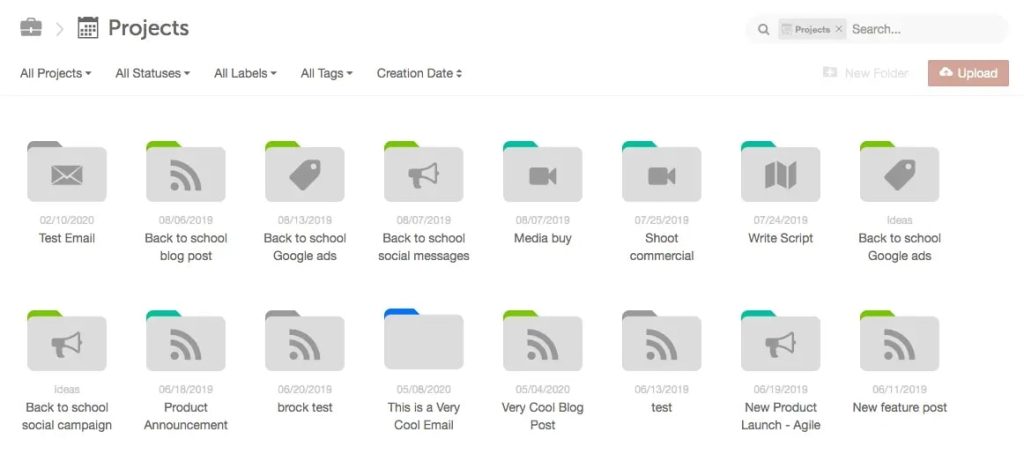
- Cross-platform campaigns: Lets you manage email + Instagram + Facebook content in one place. A massive win for time savings.
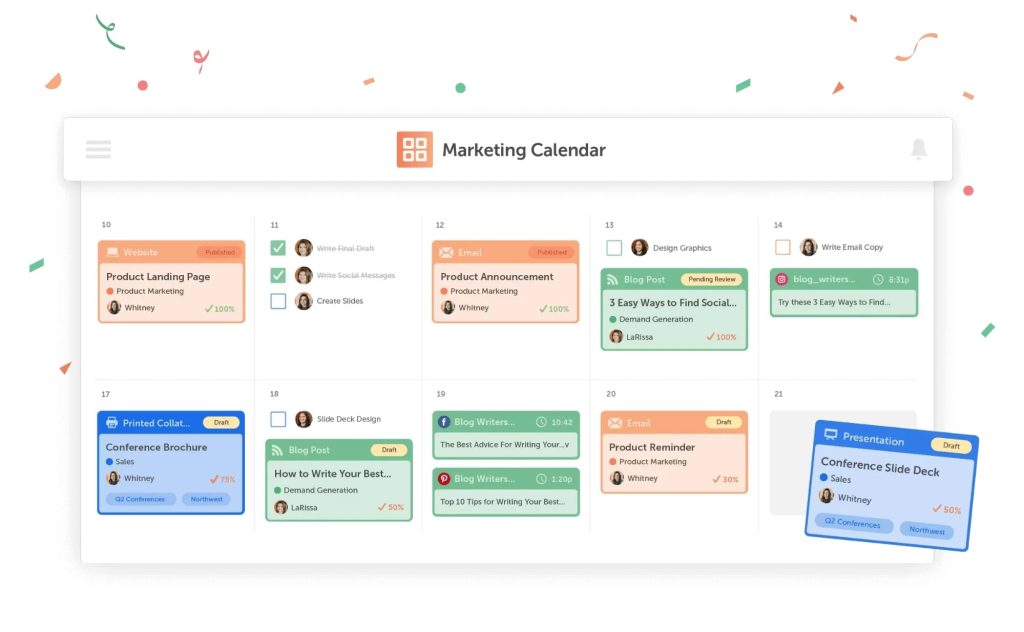
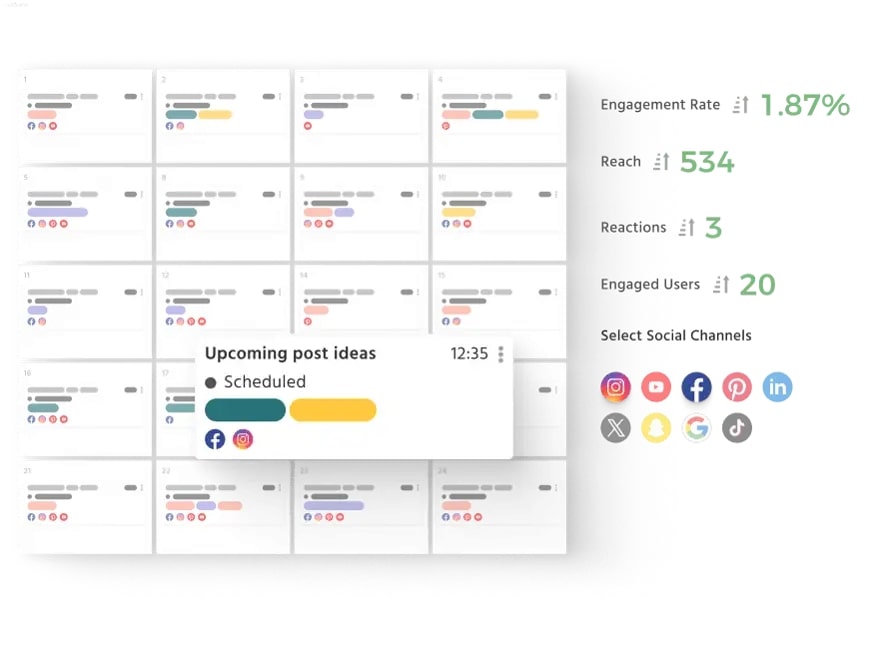
❌ Cons:
- Overkill for solo users: All those approvals and steps become noise if you’re the only one managing content.
- Less focused on visuals: These tools prioritize structure over aesthetic preview, which makes them less ideal for grid-focused Instagram brands.
Shared strength: Both tools excel at campaign management, team collaboration, and multi-platform scheduling, making them particularly useful for small businesses or influencer teams who:
- Launch seasonal promotions or product drops
Need approval workflows - Operate across Instagram, email, and other social channels
Similar weaknesses: Neither tool is ideal for highly visual Instagram planning (like grid previews), and both are arguably overkill for solo users, which makes the comparison natural.
💰 Pricing:
Loomly
- Base: $26/month
- Standard: $59/month
- Advanced: $129/month
- Premium: $269/month
CoSchedule
- Free Calendar: $0
- Social Calendar: $19/month per user
- Agency: $59/month per user
👔 Best For:
- Product-based businesses launching campaigns
- Agencies or influencer teams that require internal approvals
Loomly shines when your team needs alignment across platforms. I used it with a small agency team to coordinate Instagram, email, and Facebook posts for a retail brand’s product launch, and it really helped streamline approvals and keep everyone on the same page.
CoSchedule, on the other hand, leans harder into the marketing calendar and campaign planning aspect. I’ve recommended it to B2B teams and bloggers who juggle blog posts, newsletters, and social all at once. It’s less about visual content and more about workflow optimization.
| Goal/Business Type | Recommended Tool(s) |
| Visual storytelling + curated feeds | Later, Planoly |
| Fast, simple, multi-platform scheduling | Buffer |
| Performance tracking + client reports | Iconosquare, Sprout Social |
| Long-term content recycling | SocialBee |
| Structured campaigns or team workflows | Loomly, CoSchedule |
| Heavy DM/comment interaction | Sprout Social |
Final Thought: Choose Strategy Over Features
The best Instagram tool isn’t the one with the most features. It’s the one that fits your workflow and goals. Think of these tools as your silent content partner. Choose based on:
- Your visual vs. data focus
- Your content volume
- Your collaboration needs
- And most importantly: your growth trajectory
Personally, I’ve bounced between these tools based on client size and campaign needs. Some tools I loved for one use case were totally overkill for another. Don’t be afraid to trial a few. Most offer free plans or trials.
Define your priorities, match them to a tool, and keep your content moving with purpose.






